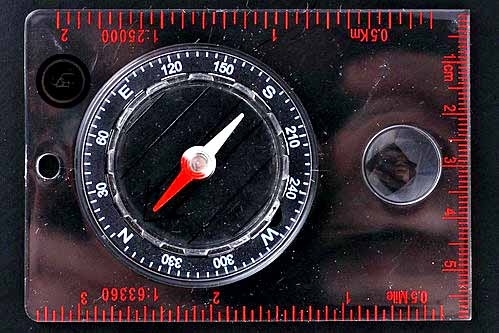For this reason, you would be wise to include a survival compass as a back-up so you can always have a sense of direction in your navigation. Learning to navigate with a compass and map is a very critical survival skill that anyone should take the time to use.
To help you out, here are the 4 best survival compasses on the market:
Phosphorescent Lensatic Compass
The neat thing about the Phosphorescent Lensatic Compass is that it can be either carried clipped securely to your belt while you walk or in its own carrying pouch. The compass is also completely waterproof, so there are very few conditions that you can’t take this compass through. Total dimensions on the Lensatic compass are 1.8 x 5.7 x 7.8 inches, with a weight of just under a half pound. This is one of the best survival compasses for the money.
Suunto A-10 Field Compass
If simplicity and efficiency is what you desire in a survival compass, then the A-10 is definitely for you. This is a very lightweight compass that is made out of scratch resistant acrylic materials and makes use of a two zone system in order to give you the most dependable readings in any part of the northern hemisphere. The ergonomic design of the A-10 allows it to fit right in the palm of your hands, the lanyard ring contains a detachable snap-lock for an extra boost of versatility. You can get ready for your life’s next great outdoor adventure and not have to worry about becoming lost with the A-10 recreational field compass.
Under Control Tactical Compass
You never want to choose the wrong compass for your next outdoor adventure or camping trip, even if it’s a military grade compass. Fortunately, this is a military grade compass that has everything in it you need, including a thumb hold, sighting hairline, magnifying viewer, and a rugged metal case to keep it thoroughly protected. In essence, this compass is the direct opposite of the more lightweight and less rugged survival compasses that are often marketed as “military grade survival compasses.” If you want tough, this just might be the best survival compass for you.
Cammenga 3H Tritium Military Compass
The 3h Tritium Military Compass from Cammenga is built to last and has been tested in numerous battlefield and tactical conditions. This is a true military survival compass in every sense of the word; it has been utilized and proved fully functional in conditions ranging from negative fifty degrees Fahrenheit to one hundred and fifty degrees Fahrenheit, and has also outlasted extended time periods in the sand, water, and through intense strain and distress. The micro lights on this compass will remain fully luminous for over a dozen years. This compass also comes fully equipped with sight wire, dial graduations in both degrees, and a magnifying glass to give you the most accurate reading possible. Finally, the strong aluminum frame keeps this waterproof compass all together. Law enforcement agencies, military units, and outdoor enthusiasts from all over the world have used the Cammenga time and time again and will continue to do so for the years to come.
Features You Need in a Compass
A true survival compass that will both lead you where you need to go and outlast gritty outdoor scenarios will need to come equipped with a number of important features.
The first, and most obvious feature, is a magnetized leader. The best compasses have a red color on the end of the needle, and this points to the magnetic field that is the strongest. In North America, that will almost always be the magnetic North Pole (different from the true north pole, which is the geographical north pole). The magnetic north pole is a chain of islands in the Canadian Arctic.
The capsule of your compass must also be filled with liquid. This fluid should also be non-freezing, so it can effectively slow down the jiggling of the needle and allow it to rest quicker. When you are in cold or high elevations, the liquid can make a bubble when it contracts, but this should not negatively impact your accuracy. When the compass has been returned to more normal conditions, the bubbles should disappear shortly.
The rotating bezel is the ring that is marked from zero to three hundred and sixty degrees and circles around the outside edge of the compass. The smaller the interval is in between the labeled degrees on your bezel, the more accurate of a reading you will be able to make. For this reason, select a compass with a rotating bezel that has many labeled degrees as possible.
The capsule of your survival compass should rest on a transparent and rectangle base. The superior compasses on the market will have centimeters and/or inches marked into the plate as well. This may not sound like an absolutely necessity, but it definitely comes in handy for when you need to measure a distance on a map.
The orienting arrow and parallel meridian lines are located on the bottom of the housing to your compass. These are essentially your north to south lines, and any survival compass you select must have these without question. If you don’t, it will be extremely difficult to properly orient your compass to a map.
Last but not least, the best survival compasses should be fully waterproof (and not just water resistant) and also be made up of a durable material, such as aluminum. One compass we recommended, the Suunto A-10, is not made out of these durable materials, but the trade off is better convenience since the A-10 is designed to sit directly in your hand and to be used quickly. You just have to weight trade-offs when selecting your compass, but with so many options, you’re bound to find the right one. Good luck!








